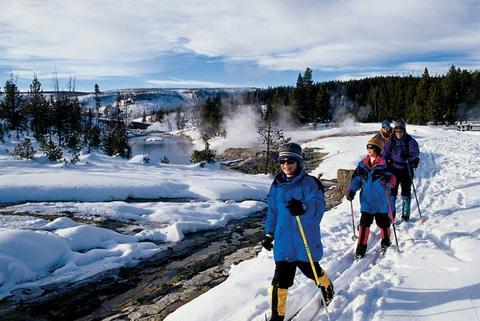For decades winter visitation to Yellowstone National Park has been a lifesaver for the December-March economies of gateway towns such as West Yellowstone, Gardiner, and Cooke City in Montana, and Jackson and even Cody in Wyoming.
The allure of cruising through the park on snowmobiles or in a snowcoach or visiting the backcountry on skis or snowshoes has funneled millions of dollars into those communities. So should there be any long-term concern that this past winter's visitation is down more than 13 percent?
Preliminary numbers show that the total number of Yellowstone visitors for December 2008 through March 2009 was 86,793, down 13.2 percent from the 99,975 visitors recorded for the 2007-08 winter season. An average of 205 snowmobiles and 29 snowcoaches a day entered the park during winter 2008-2009. That compares to an average of 294 snowmobiles and 35 snowcoaches a day during winter 2007-2008.
The number of people driving through the park’s North Entrance from December through March totaled 47,259; down slightly from 50,175 the previous year.
Park managers believe a lack of early season snowfall and continued legal uncertainty surrounding over-snow travel at the beginning of the season, coupled with the weak economy, all contributed to the decline in winter visitor numbers. But they're quick to point out that winter visitation to the park is minute when compared to summer tourism.
In a release park officials say winter visitation represents a small but important portion of Yellowstone’s annual visitation, which again topped the 3-million mark in 2008. During the peak of summer, more people visit the park in just four days than visit during the months of December through March combined.
Despite a recent U.S. Commerce Department report showing that nationwide travel spending was down 22 percent during the last quarter of 2008, a staff analysis of impacts on park visitation during previous recessions shows economic downturns have had a limited impact on annual visitation to Yellowstone. History also indicates that even though Yellowstone visitation has declined some at the onset of previous recessions, as the economy has recovered, visitor numbers have bounced back to equal or exceed pre-recession levels.
While downplaying this winter's decline in traffic, Yellowstone officials, with an eye on marketing, are quick to point out what a great value visiting the park can be.
"The National Park Service Office of Tourism is relatively upbeat about summer travel to the national parks; noting that during tough economic times many families decide to take shorter trips to authentic, domestic destinations such as Yellowstone," they said in a release.
"Visiting the national parks remains a good value. A seven-day pass good for both Yellowstone and Grand Teton is just $25; a pass good for entrance to any national park for an entire year is just $80. Many travel costs have declined, with gasoline prices currently half what they were last summer. Overnight stays in Yellowstone are available for as little as $12 a night at some park campgrounds, and special lodging rates are being offered on rooms in the park and in nearby communities."




Comments
My husband and I have visited yellowstone many times, in all seasons. By far, our favorite time is winter. We get very little snow where we live, and it is such a treat to have ALL that snow! The uncrowded conditions (except for bison and elk), the thermal features, and landscapes are all superb during that season. However, we have decided not to visit during winter for the past several years. Not because of earthquake scares, but because we do not want to be required to snowmobile with a guide. We always have rented 4-cycle engine snowmobiles (much less stinky and noisy), always stay on marked trails, are courteous to other visitors and wildlife, and we obey all other rules and speed limits. I believe there are other people like us, and I think that in addition to other factors already mentioned, the required use of guides may deter many visitors. Perhaps some of the money wasted by keeping the Cody route open could be put to better use in heightened enforcement of the existing rules. Also, it would make sense if ONLY 4-cycle engines were allowed in the park.